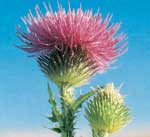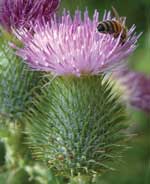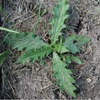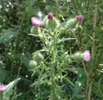Bull thistle
Cirsium vulgare (Savi) Tenore
Keys to Identification
- Leaves are prickly-hairy above and cottony below
- Has stiff pointy spines on leaf tips
This information courtesy of the Colorado Natural Areas Program
Family
Asteraceae (Composite)
Other Names
Common Thistle, Spear Thistle, Fuller’s Thistle
USDA Code
CIVU
Legal Status
Colorado Noxious Weed List B
Identification
Lifecycle
Biennial
Growth form
Forb/herb
Flower
Flowers are 1.5-2 in wide and clustered at the ends of branches. The flower bracts are somewhat tapered and covered with spines (Whitson et al. 1996). Flowers are pinkish to dark purple.
Seeds/Fruit
Seeds are capped with a circle of plume-like white hairs.
Leaves
Leaves are alternate. Bull thistle is the only thistle in Colorado that are prickly hairy on the top surface of the leaves and cottony-hairy on the undersides.
Stems
In mature plants the leaves extend down, clasping the stem and are divided into segments (i.e. strongly decurrent).
Roots
Has a short, fleshy taproot with several primary roots extending from the root crown. Each bears a number of smaller lateral roots.
Seedling
Seed leaves (cotyledons) are round to spatulate (spoon shaped), and smooth. First true leaves are oval to spatulate with spines and a rough, bumpy surface (Carey et al. 1993). First year plants form a rosette with leaves easily distinguished from other thistles by the above leaf characteristics.
Similar Species
Exotics
Could be confused with musk thistle.
Natives
There are many nativeCirsiumspecies, some common(Cirsium undulatum)some rare(Cirsium perplexans). The natives generally do not have leaves clasping the stem all the way from node to node (strongly decurrent leaves), and many have hairy upper and lower leaf surfaces and are blue-green or gray.
Impacts
Agricultural
Heavy infestations can exclude livestock from areas. Additionally, the presence of bull thistle in hay decreases the forage value and lowers the market price (Zimmerman 1997). It is an aggressive weed, but it will not survive where cultivation has cut back its stem and destroyed its root system (FEIS 1998).
Ecological
Bull thistle is often a transient species, appearing in recent clear cuts or disturbed areas and becoming a dominant species for several years (Rees et al. 1996).
Human
Bull thistle has been reported to cause hay fever in some individuals (FEIS 1998).
Habitat and Distribution
General requirements
Bull thistle grows in dry to moist habitats. It thrives on nitrogen-rich soils, and it grows on gravelly to clay-textured soils. Bull thistle cannot withstand deep shade, and is nearly absent if light is reduced to less than 40% of full sunlight (FEIS 1998). Potential habitats include pastures, overgrazed rangeland, roadsides, and logged areas.
Distribution
Within Colorado bull thistle infestations have been reported to occur in nearly all counties west of the continental divide, this plant has also been observed in the Upper Arkansas Watershed and in pockets on the plains. It is widespread throughout the United States and parts of Canada.
Historical
Bull thistle was introduced to North America as a seed contaminant and is now widespread.
Biology/Ecology
Life cycle
Biennial
Mode of reproduction
Seed
Seed production
Mature plants can produce up to 4,000 seeds per plant (Zimmerman 1997).
Seed bank
Seeds have little dormancy, and germinate rapidly whenever conditions are favorable, usually in the spring and fall (FEIS 1998). Although most of the seeds on or near the surface do not remain viable for more than a year, seeds that are buried at a depth of 5 in may remain viable for up to 3 years (Zimmerman 1997).
Dispersal
Seeds are capped with a circle of plume-like white hairs and can be windblown for long distances. However, it has been found that 65% of the seeds land within two meters of the parent plant (Zimmerman 1997).
References
Calweed Database. 1997. California Noxious Weed Control Projects Inventory. Natural Resource Projects Inventory, Information Center for the Environment, University of California, Davis. Available: http://endeavor.des.ucdavis.edu/weeds/
Carey, J. Boyd, James J. Kells, and Karen A. Renner. 1993. Common Weed Seedlings of Michigan. Department of Crop and Soil Sciences Michigan State University Extension Bulletin E-1363. Internet 10/27/99. Available: http://www.msue.msu.edu/msue/iac/e1363/e1363.htm
Colorado Natural Areas Program. 2000. Creating an Integrated Weed Management Plan: A Handbook for Owners and Managers of Lands with Natural Values. Colorado Natural Areas Program, Colorado State Parks, Colorado Department of Natural Resources; and Division of Plant Industry, Colorado Department of Agriculture. Denver, Colorado. 349 pages.
FEIS – Fire Effects Information System [Online] (1996, September). Prescribed Fire and Fire Effects Research Work Unit, Rocky Mountain Research Station (producer), US Forest Service. Available: www.fs.fed.us/database/feis/ [1998,March 12]
Rees, N.E., P.C. Quimby Jr., G.L. Piper, E.M. Coombs, C.E. Turner, N.R. Spencer, and L.V. Knutson (editors). 1996. Biological control of weeds in the west. Western Society of Weed Science in cooperation with USDA Agricultural Research Service, Montana Department of Agriculture, and Montana State University.
USDA, NRCS. 2005. The PLANTS Database, Version 3.5 (http://plants.usda.gov). Data compiled from various sources by Mark W. Skinner. National Plant Data Center, Baton Rouge, LA 70874-4490 USA
Whitson, T.D.(ed.), L.C. Burrill, S.A. Dewey, D.W. Cudney, B.E. Nelson, R.D. Lee, R. Parker. 1996. Bull thistle. Weeds of the West. Western Society of Weed Science, in cooperation with the Western United States Land Grant Universities Cooperative Extension Services, Newark CA. pg. 118.
Zimmerman, J.A.C. 1997. Ecology and distribution of Cirsium vulgare (Savi) Tenore, Asteraceae. USGS Southwest Exotic Plant Mapping Program. Internet 1/21/99. Available: http://www.usgs.nau.edu/swemp/




